RUNYONII Rose ex Walther, 1935 (engl./ fr.)
Synonym : Echeveria runyonii var. macabeana
Series Pruinosae
Type : R. Runyon, s.n., collected in a garden at Brownsville, Texas and sent to Rose 1922, i.e. the type is from a cultivated plant without known origin (US 1319920).
Etymology : Named for its collector, Robert Runyon.
Distribution : Mexico (Tamaulipas : Sierra San Carlos, - not Nuevo León, as wrongly indicated in IHSP).
Description (of the plant from the Sierra San Carlos, Tamaulipas, by M. Kimnach in IHSP, 2003) :
Stem usually single, to 10 cm long or more, ± 1 cm in diameter.
Rosette 8 – 10 cm in diameter.
Leaves spatulate-cuneate to oblong-spatulate, truncate to acuminate, mucronate, 6 – 8 x 2,5 – 4 cm, glaucous pinkish-white.
Inflorescences 2 or more, 15 - 20 cm tall, with 2 – 3 cincinni, bracts conspicuous, pedicels ± 4 mm.
Flowers : Sepals ascending-spreading to 11 mm, corolla pentagonal, 19 – 20 x 10 mm in diameter, scarlet.
The cytology n = 14 refers to the plant sent to Rose from Brownsville, Texas, not to E. runyonii from the Sierra San Carlos. The cytology of the latter is not reported.
Note :
The history of Echeveria runyonii
In 1922 J.N. Rose received a plant, sent from Brownsville, Texas, by Robert Runyon who had collected it as a cultivated plant in a garden. The following year it flowered in Washington and Rose described and named it – for its collector – E. runyonii. Rose's description was never published during his lifetime and it only became known through Walther's publication in CSJ US 7: 69. 1935. The latter had never seen the original plant, but he knew a somewhat similar plant which had been distributed by the Californian nursery McCabe and he described it as E. runyonii var. macabeana. The origin of this plant is completely obscure, i.e. there is no evidence whatsoever that it could be descended from the plant described by Rose. Walther stated that his new var. macabeana differed from the type only in more acute leaves, thereby overlooking that Rose had described the leaves as "truncate to retuse or acute", which of course makes his new description superfluous.
It was not until the 1990s that a comparatively similar plant was found in the Sierra San Carlos in Tamaulipas and though it differed from the original description by Rose in being distinctly caulescent and much less pruinose it was considered the "true" E. runyonii. Strictly speaking this is not correct because, as is well known, the name belongs to the type.
So at the end of the day we have 3 E. runyonii, two originating in cultivation and one found in the wild in the Mexican state Tamaulipas, the type being the plant sent from Brownsville, Texas, by Robert Runyon.
While obviously Rose's plant most likely was not spread further, regarding the Californian plant, published by Walther as E. runyonii var. macabeana, this was quite different : In the course of the years nurseries named several cultivars, such as ‘Texas Rose’, ‘Dr. Butterfield’, ‘Lucita’, ‘Tom Allen’, which are so slightly different that they hardly deserve different cultivar names. And because apparently none of them has been described or defined, it is not even clear whether the above mentioned names are applied properly. A more distinct cultivar is called E. runyonii ‘Cook’s Pride'.
The most interesting cultivar is certainly the mutation with leaves appearing to be positioned upside-down, named by Myron Kimnach as E. runyonii 'Topsy Turvy'.
A cristate form of E. runyonii 'Topsy Turvy' was published as E. runyonii 'Illusion' by Harry Mak in Photo album of succulents in color 3: 109 (Mar 2003).
--------------------------------------------------------------------------------------------------
Synonyme : Echeveria runyonii var. macabeana
Série Pruinosae
Distribution : Mexique (Tamaulipas : Sierra San Carlos - pas dans le Nuevo León, comme indiqué à tort dans IHSP).
Description (de la plante de la Sierra San Carlos, Tamaulipas, par M. Kimnach dans IHSP, 2003) :
Tige habituellement simple, 10 cm de long ou plus, ± 1 cm de diamètre.
Rosette 8 – 10 cm de diamètre.
Feuilles spatulées-cunéiformes, tronquées à pointues, mucronées, 6 – 8 x 2,5 – 4 cm, blanc rosâtre glauque.
Inflorescence 2 ou plus, 15 - 20 cm de long, avec 2 – 3 cymes, bractées bien visibles, pédicelles ± 4 mm.
Fleurs : Sépales droits, écartés, jusqu'à 11 mm de long, corolle pentagonale, 19 – 20 x 10 mm de diamètre, écarlate.
La cytologie n = 14 se réfère à la plante envoyée à Rose de Brownsville, Texas, et non à E. runyonii de la Sierra San Carlos. La cytologie de la dernière n'est pas signalée.
Note :
De nombreux cultivars de cette espèce ont été nommés, par exemple : ‘Texas Rose’, ‘Dr. Butterfield’, ‘Lucita’, ‘Tom Allen’ (en Australie). Ces plantes ne sont pas sensiblement différentes d'E. runyonii, et ces dénominations ne doivent être que des noms attribués par des producteurs pour des plantes non reconnues en tant qu'espèce, ou rebaptisées pour un catalogue. A notre connaissance, aucun de ces cultivars n'a été décrit, et nous ignorons donc si les noms mentionnés ci-dessus s'appliquent aux bonnes plantes. En outre, à partir d'une feuille, l'on peut obtenir n'importe laquelle de ces formes ; voire deux formes de feuilles différentes à partir d'une seule, pouvant muter, à tout moment, en E. runyonii ‘Topsy Turvy’.
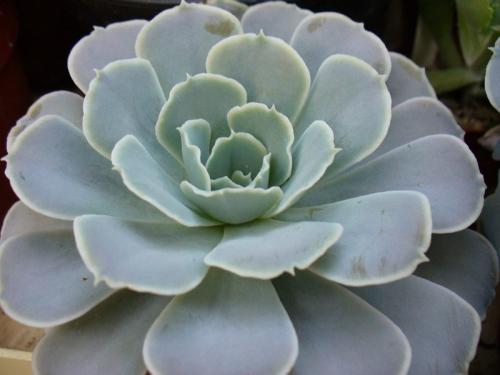
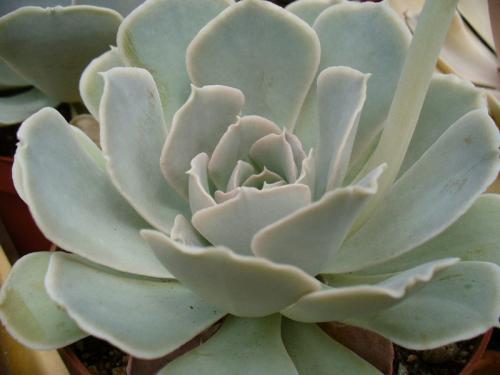
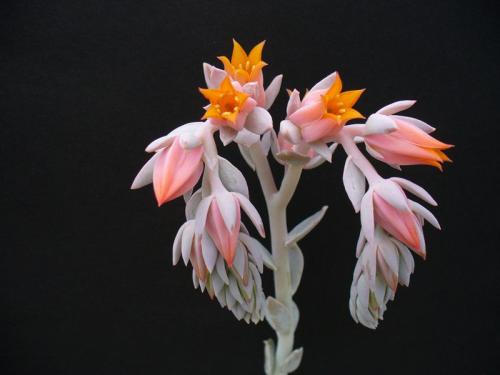
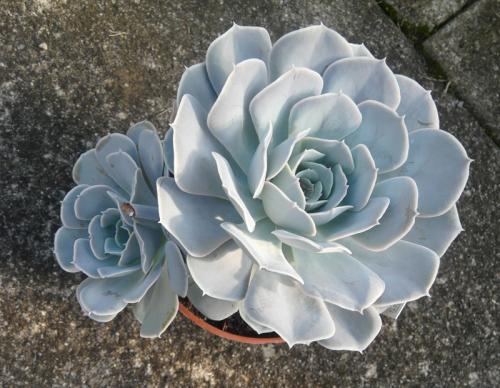
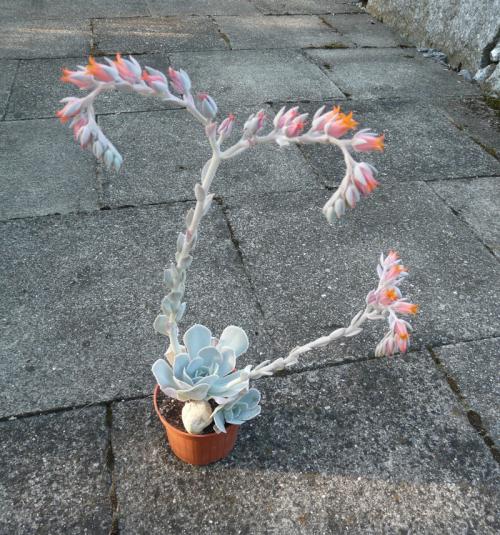
Photos Margrit Bischofberger
An interesting mutation, with leaves appearing to be positioned upside-down, is E. runyonii 'Topsy Turvy' which originated in cultivation in California. Very often the flowers are heavily distorted and more rarely even the flower stalk is fasciated. A cristate form of E. runyonii 'Topsy Turvy' - probably no longer existing - was published as E. runyonii 'Illusion' by Harry Mak in Photo album of succulents in color 3: 109 (Mar 2003).
Une intéressante mutation, avec feuilles positionnées à l'envers, nommée E. runyonii 'Topsy Turvy', laquelle est d'origine horticole, de Californie. Les fleurs sont très souvent déformées et, plus rarement, la hampe florale peut être cristée :